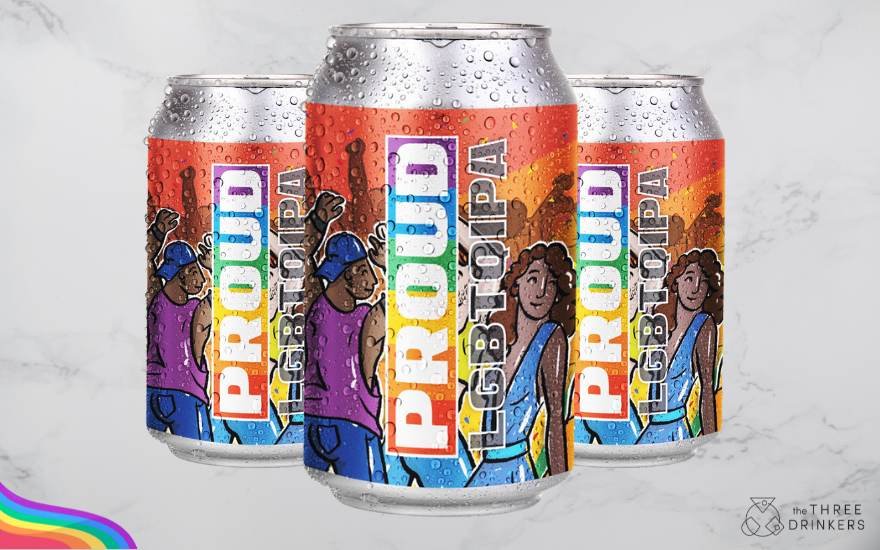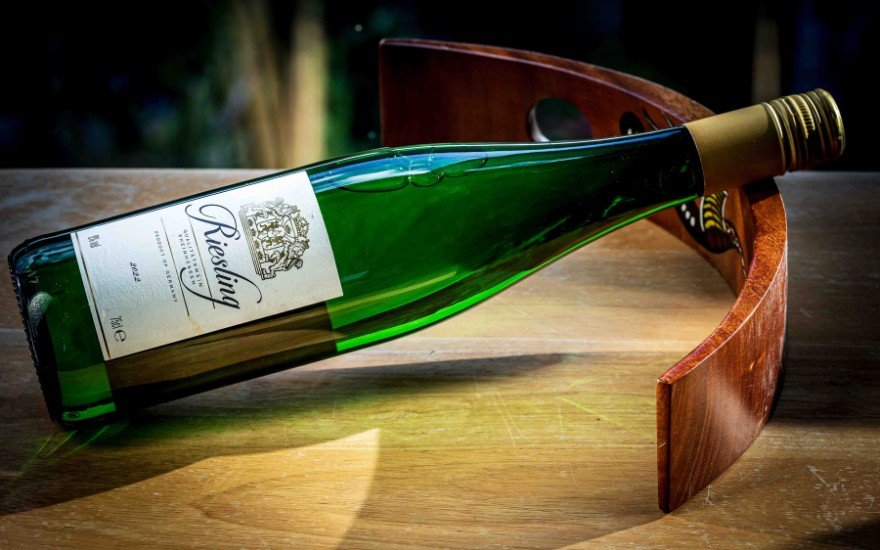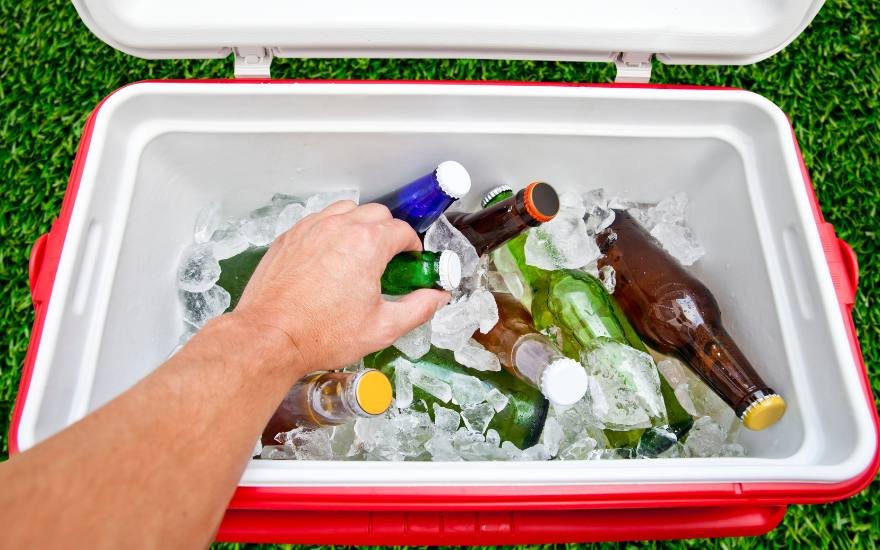Pride Month is one of our favourite times of the year, and of course, so many drinks brands are happy to get involved. But as Pride draws to a close, we want to celebrate our favourites, old and new, that really go the extra mile and support LGBTQIA+ communities. Whatever your chosen tipple, we’ve found a drink that you can enjoy whenever you’d like knowing that they support the cause all year round.
GIN
Puerto de Indias Strawberry Gin Unlimited Edition LGTBIQ+
This Spanish Strawberry Gin from Puerto de Indias continues to fly the rainbow flag proudly. Made with fresh strawberries macerated for 48 hours before distillation, this process intensifies the flavours and aromas of the fruit considerably. They’ve made a point of stating that it’s not a Limited Edition by calling the opposite – an Unlimited Edition.
Size: 700ml
ABV: 37.5%
Find here: £26.34
Spirit of Stonewall Gin
Made at the family distillery in Lincolnshire comes the delicious Spirit of Stonewall London Dry gin. Their inspiration came from the Stonewall Riots and they provide all year advocacy support of LGBTQIA+ including donating £1 from every bottle or gift pack to support LGBTQIA+ causes. Their complex London Dry has botanicals of juniper, coriander, orange, liquorice, almonds, the tangy coastal berry and sea buckthorn. Check out their Passionfruit and Mango, Pink Rhubarb and Raspberry Gins too.
Size: 700ml
ABV: 40%
Find here: £36
Brighton Gin
From the UK’s gay capital comes this handmade craft gin brand that started in 2012. From small beginnings, it’s now available internationally! Look how absolutely stunning their 9th Limited Pride Edition is too with that glammed up Brighton seagull, courtesy of ‘queerodivergent’ artist Ladypat. Bravo! So much effort has been put into this gin, right up to the hand-mixed wax. A portion of the profits go to the local Clare Project too. As for the liquid, it’s super smooth with multiple awards loving it. Watch out for the delicious orange and liquorice notes.
Size: 700ml
ABV: 40%
Find here: £38
VODKA
Crystal Head Pride Edition
Crystal Head’s Pride Edition, an annual limited release that we love, stands out as the most theatrical bottle on the market. This vibrant rainbow-painted piece supports organizations like the Kaleidoscope Trust and Stonewall. Inside, enjoy their signature Canadian corn vodka, distilled four times with pure Newfoundland water and Herkimer diamond filtration, featuring hints of sweet citrus and vanilla.
Size: 700ml
ABV: 40%
Find here: £42.49 (usually more!)
Absolut Rainbow Pride
Long time ally, Absolut’s Pride edition features the proud, striking rainbow bottle in their permanent collection. Made with Swedish waters and winter wheat, this smooth, creamy vodka earned high praise at recent awards. Partnered with GLAAD, Absolut supports cultural change for acceptance, honouring Gilbert Baker's original Pride flag design.
Size: 700ml
ABV: 40%
Find here: £22.25
Supergay Vodka
Beautifully hand crafted in upstate New York, Supergay uses 100% organic corn from local sources and is filtered through activated coconut charcoal too for a clean, no-nasties expression. Super smooth and silky. Great vodka and amazing ethos. Only available in the US unfortunately, where local charities receive a portion of the profits.
Size: 750ml
ABV: 40%
Find here: $30
Tom of Finland Vodka
Introducing Tom of Finland, aka Touko Laaksonen, a gay icon whose art revolutionized gay culture. His masculine, homoerotic creations adorn the standout vodka bottle. Crafted organically by Master Distiller Mika Mönkkönen at Finland's second oldest family distillery, Lignell & Piispanen, this vodka is distilled five times for smoothness, boasting subtle rye spice and no burn. Proceeds support the Tom of Finland Foundation, making each purchase meaningful. Legendary.
Size: 500ml
ABV: 40%
Find here: £25.05
RUM
Ninefold Pure Single Rum
This eye-catching Scotch Rum is produced at Ninefold’s distillery in Dumfries. Ninefold have really engaged with Pride this year, actively championing people through displaying how inclusive the drinks industry can be, donating to Equal Measures, enlisting queer bartenders as much as possible and sponsoring queer-led events. This rum itself is an unaged white, though they have a wide range of exceptional creations. It’s distilled from molasses and delivers a kiss of ginger spice, vanilla and lively citrus.
Size: 700ml
ABV: 40%
Find here: £34.44
WINE
Digby Fine English
Jason Humphries and Trevor Clough, inspired by a seventeenth-century alchemist named Sir Kenelm Digby and their experiences in Seattle wineries, launched Digby English Sparkling wines. Their bubbles consistently outshine Champagne in blind tastings, a testament to their dedication to excellence and diversity in the world of wine.
Size: Various
ABV: Various
Find here: From £28
Madame F Rosé
Madame F proudly collaborates with Queer Britain, sponsoring the Madame F Queer Britain art award since 2022. LGBTQ+ artist Justin Kemp’s winning artwork adorns every bottle. Inspired by the community, Madame F offers collections bursting with pride and passion. Their Rosé is refreshingly fresh, light, and juicy—a perfect tribute to their vibrant spirit. Give it a try!
Size: 750ml
ABV: 11%
Find here: £9.50
Gentleman Farmer 2021 Napa Valley Pride Red Wine
If you are visiting the U.S. then keep your eye open for Californian vintner duo Joe Wolosz and Jeff Durham, who specialise in creating rich and fruity Cabernet Sauvignon and delicious Chardonnays. They have created a premium limited edition 2021 blend of Napa Valley Pride Red Wine. This is an exciting blend of Merlot and Cabernet Sauvignon, with hints of mulberry, redcurrants and vanilla. 10% of sales from this goes to support LGTBQ+ youth organisations.
Size: 750ml
ABV: 14.5%
Find here: $119
Barefoot Wines Pink Moscato
Since 1988, for over 30 years Barefoot Wines has been a proud supporter of many different LGBTQIA+ organisations and you can often find them at many Pride festivals, showing their long-term support for this community. They have a wonderful range of delicious wines to choose from depending on your preference. Perhaps you might opt for a rich Merlot, a lighter fresh Sauvignon Blanc or a sweeter Moscato like this, whichever you choose there is bound to be something you will enjoy. Great value too.
Size: 750ml
ABV: 9%
Find here: £7.25
CANNED DRINKS
LUV JUS
Inspired by Tel Aviv Pride 2016, housemates George and Owen launched a line of healthy craft vodka pops. Recognized by the Great Taste awards, their vegan-friendly, gluten-free creations include flavours like pineapple-mint, blood orange-pomegranate vodka, and raspberry-cucumber gin. Though the truth is, there’s a lot more depth of flavour in each can than that suggests, with Korean ginseng also included in each flavour. Each drink is low-calorie with no added sugar, supporting LGBTQ+ charities with 5% of profits—a perfect choice for Pride Month… and beyond.
Size: 150ml
ABV: 4.6%-4.8%
Find here: 6 for £15
The Drinks Bureau Dirty Shirley and Non-Alc Shirley Temple
Serious, award-winning canned cocktails and mocktails. First, the 0% Shirley Temple, a cherry-flavoured drink with warm ginger, tang and bitter touches. Then it’s alter ego – Dirty Shirley which brings the same flavour profile as well as steely vodka and a little more lemon zing. Stylish and delicious. 10p from each can goes to Stonewall Housing to support LGBTQ+ people facing homelessness.
Size: 250ml
ABV: 5% / Non-Alcoholic
Find here: £15 Dirty Shirley / £12 Shirley Temple (for 4)
BEER
PROUD
PROUD LGBTQIPA, coined as the original Queer Beer by founders Ethan and Sören, blends elderflower and citrus in a refreshing IPA. Supporting Diversity Role Models, LGBT Foundation, and Terrence Higgins Trust, £2.40 from every case (20p per can) aids these charities. Joining their Loyal Hunny group offers 10% discounts and more perks, making PROUD a delightful choice year-round. Love it.
Size: 330ml
ABV: 4.1%
Find here: £28 for 12
Queer Brewing Project
This is a great queer and trans-owned brewery looking to increase representation for their community in the world of beer. Based in London, they have lots of pop-ups so check out their Instagram or website for the next one! They’ve got a load of really intriguing beers, including special collaborations with Queer Britain currently sold out at the time of writing. But we love the look of their Witbier – Flowers. As bright and beautiful as a special bouquet, it balances snappy hops with bold coriander seed and orange peel.
Size: 330ml
ABV: 4%
Find here: £25.80 for 8
Athletic Brewing Ultimate Mixed Case Low-Alcohol
Athletic Brewing are based on both the east and west coasts of the US, with a huge, highly innovative brewing operation enabling unique flavour intensity in their low-alcohol beers. Focused on not just physical health but mental health too, they’ve got an extensive history with LGBTQI+ advocates, creating many specialist beers over their time. Their variety pack is a great way to start, featuring Run Wild IPA, Upside Dawn, Lage and All Out – an accessible range of refreshing golden ales, bold hops and rich roasted malts.
Size: 355ml
ABV: 0.5%
Find here: £20.10 for 8
Portobello Brewery - Polari
Portabello have been independently crafting distinguished beers and ales in West London since 2012. Polari is one of their best selling at different venues, and it’s brewed to support Stonewall Housing, with 10p from every pint donated. If you didn’t know, Polari is a secret language, originally used by people in theatres and fairgrounds and adopted by gay people in the 20th century to skirt the UK’s strict anti-homosexuality laws!
Size: 330ml
ABV: 4.2%
Find here: Various venues
Drop Bear Beer Co – Low Alcohol
Drop Bear stands proudly as the world’s inaugural alcohol-free brewery owned by an LGBT+ couple, Joelle and Sarah. The couple’s resolve was strengthened after a hate crime in 2022, reinforcing their commitment to combating discrimination and violence. Embracing their role as Galop Guardians since June 2022, Drop Bear Brewery champions inclusivity and community empowerment through their craft. This multi-pack of ‘near beers’ includes moreish New World Lager, unique Yuzu Pale Ale, tropical IPA and smoky Bonfire Stout. Taste for yourself to see what all the rave reviews are about!
Size: 330ml
ABV: 0.5%
Find here: £11.99 for 4
COCKTAILS
Tom Savano Finnish Liberation Cosmopolitan
Tom Savano crafts artisanal small-batch cocktails using Fairtrade, organic ingredients. Their Cosmopolitan Pride mix, rooted in the 1980s Cleveland gay scene, features Tom of Finland Organic Vodka—a tribute to the iconic gay artist. Just chill and pour with pride! A delicious ready to pour bar-standard cocktail – voila!
Size: 500ml
ABV: 20%
Find here: £22
Want some ready to drink cocktails to celebrate more? Check out our favourites here!









































































